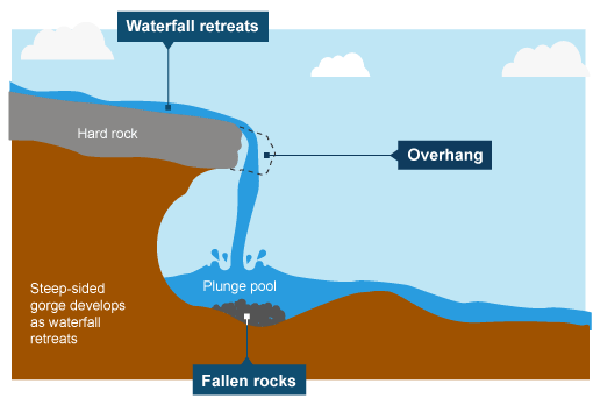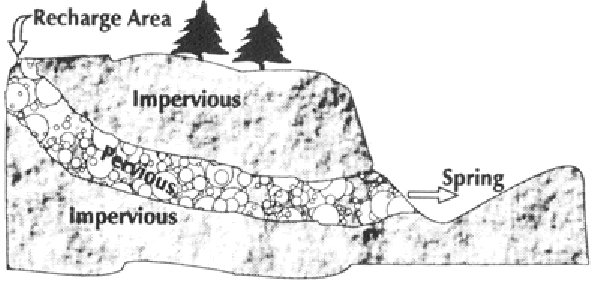Waterfall

Waterfall formation is based around the basic principle that there is a watercourse (water is an erosive agent) traversing over different layers of rock each with different rates of erosion. In other words, you have a river or stream flowing over hard rock (erosion is slow) and also flowing over soft rock (erosion is more rapid).
Over time, the soft rock is further cut into by the water ultimately making the watercourse steeper beyond the hard rock layer. This steepening effect also accelerates erosion as the influence of gravity on the water increases the water's speed (the increasing slope accelerates erosion). Eventually, the watercourse steepens until it is either near or completely vertical. At this point, you have a genuine waterfall.
With the watercourse continuing to cut into the softer rock, the waterfall gets taller, the plunge pool (where the waterfall lands) gets deeper, and the soft rock directly beneath the hard rock gets undercut. The undercutting action results in waterfalls where you might be able to go behind the water like a curtain.
As the undercutting continues, eventually the overhanging hard rock gets unstable and collapses into the base of the waterfall. The net result of this action is that the waterfall retreats further upstream to the remaining lip of the hard rock layer. For example the well-known Niagara Falls retreats at an average of 900mm to 1m each year.
The undercutting still continues until you run out of the hard rock layer. At that point, the watercourse will probably go back to being a stream or rapid.
Questions
Q1. Is there a plunge pool or any overhanging rock visible at these falls? Tell me why this is, based on supplied information?
Q2. Estimate the height of the falls at the right.
Mineral Spring

Sailors Falls Mineral Spring is just one of five mineral springs that have found nearby.
Springs flows because the pressure in the aquifer (water bearing soil or rock), which is covered by a confining layer (clay or other impervious material), is greater than atmospheric pressure at the land. A spring is formed when the water reaches the surface through a fracture or porous layer. These types of springs usually occur along faults (a fracture in the earth), or in areas of great topographic relief such as cliffs or valleys.
Water is a natural solvent capable of dissolving many other substances as it flows through the Ordovician slate and sandstone of the area. Spring waters may contain dissolved minerals and gases that give them subtle flavours. Without minerals and gases, water tastes flat. The most common dissolved mineral substances are calcium, magnesium, sodium, potassium, chloride, sulphate and bicarbonate. However, water is not considered desirable for drinking if it contains more than one thousand milligrams per litre (mg/l) of dissolved minerals. In areas where less-mineralized water is not available, water with a few thousand mg/l of dissolved minerals is used routinely, although it is classified as saline.
Questions
3. Name 2 minerals present in the water here? (Sign)
4. Taste test: describe the taste of the water.
5. Briefly describe how a mineral spring occurs and what happens to the water?
Post a picture of yourself at the mineral springs pump. (Optional)
Please feel free to log at your leisure, but logs without corresponding message will be deleted.